Select units of measurement for the temperature and rainfall tables (metric or imperial).
Average weather, temperature, rainfall, sunshine
As the name suggests, Ecuador is bisected (in the north) by the Equator, the imaginary line that divides the Earth into two halves, and where the day lasts 12 hours throughout the year. Therefore, one would expect an
equatorial climate, hot and humid with year-round rains, but this is only true for the eastern part of the country and the northernmost part of the coast, both covered by forests.
In fact, the central part is crossed by the
Andes and is therefore more or less cold depending on altitude, while almost all of the western part, on both the
plain and the coast, is affected by a cool ocean current (the
Humboldt current), which lowers a bit the temperature and makes the climate more
arid, especially from May to December.
Index
The forest
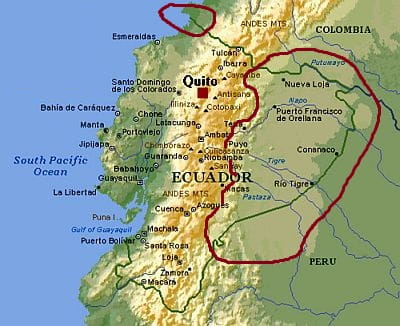
In the northernmost part of the coast, we find a small area occupied by forests and mangroves, where the climate is
equatorial, hot and humid all year round, with constant rains; in Valdez, near the border with Colombia, 2,400 millimeters (95 inches) of rain fall per year.
Nuevo Rocafuerte
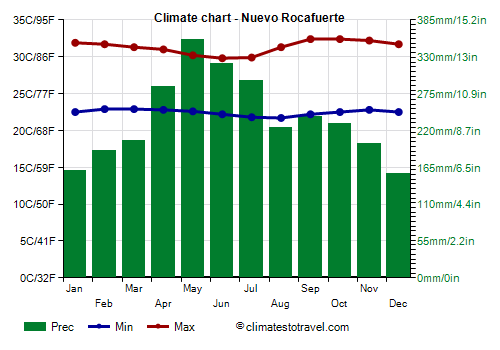
Across the vast
Amazon area to the east (see Nuevo Rocafuerte), there is an equatorial climate as well, hot and muggy climate all year round.
The amount of rainfall is quite remarkable, around 2,800/3,000 millimeters (110/118 inches) per year in most of the plains. The rains occur primarily in the form of heavy showers or thunderstorms in the afternoon.
The (relatively) least rainy period is from August to November in the north-west, while in the Amazon, it is from November to March, when, however, from 150 to 200 mm (6 to 8 in) of rain fall per month.
Puyo
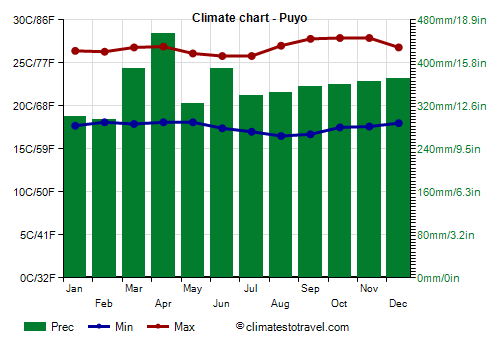
In the central area of the country, along the eastern slopes of the Andes, we find the rainiest part of the country.
In the city of
Puyo, at almost 1,000 meters (3,300 feet) above sea level, and therefore at the boundary between the
tierras calientes and the
tierras templadas, 4,300 millimeters (170 inches) of rain fall per year, and it rains almost every day.
The only consolation is that the altitude makes the temperatures pleasant: the daily average is around 20 °C (68 °F) all year round.
In Puyo, there is not much sun because the sky is often cloudy.
Here, it doesn't really make sense to speak of "best time", however, January and February are the only months when rainfall amounts to "only" 300 mm (12 in) per month.
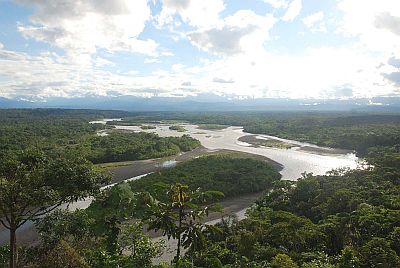
The plain
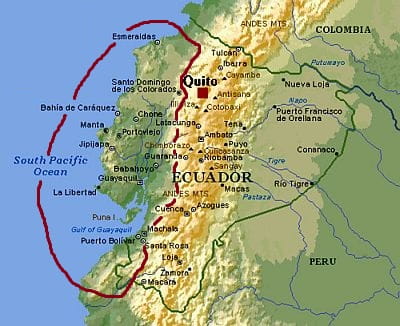
In the area of Ecuador west of the Andes, we find a plain, which has a
tropical climate, with a dry season (which goes from July to November in the north and from May to December in the south) and a wet season (December to June in the north and January to April in the south), although the rainfall varies greatly: in general, the coasts are drier than the areas at the foothills of the Andes, and the north receives more rainfall than the south.
In fact, the coast, especially in the central-southern part, is affected by the
Humboldt current, which brings a cool period with little rain (in which, however, the sky is often cloudy and mists can form), which gradually becomes longer going south.
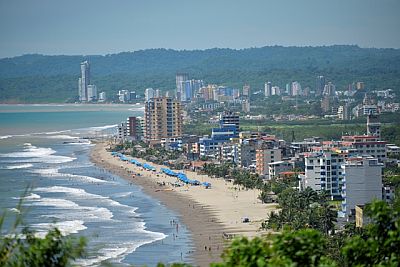
In the northern part of the coast (see Esmeraldas, Atacames), it is hot all year round, with highs of 28/30 °C (82/86 °F). Some rains, in the form of showers or thunderstorms, can occur throughout the year, even though rains of some importance, and sometimes abundant, occur only from January to June.
The sun is rarely seen all year round; above all, it is rare for it to shine intensely, since it is often veiled by
mist or by a
cloud layer; paradoxically, this happens more often in the driest period.
The sea in the northern part of the coast is warm all year round.
Manta
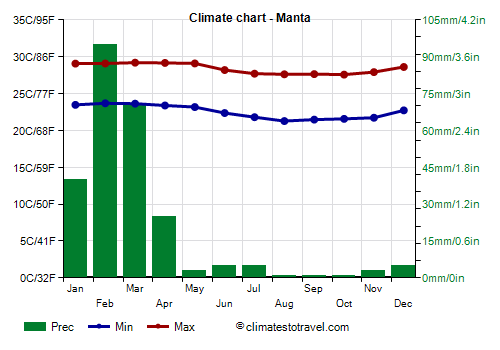
In the central part of the coast, the temperature is still high throughout the year, though it slightly decreases in the austral winter and spring. For example, in
Manta, the maximum temperatures drop to 27.5/28 °C (81.5/82.5 °F) from July to October.
Already in the central part of the coast, the cool sea current inhibits the formation of rain clouds for many months a year: rainfall amounts to 500 mm (20 in) in Bahia de Caraquez and to only 250 mm (10 in) in Manta.
Nevertheless, here too, the amount of sunshine is low, in fact, the sky is often cloudy, and
fogs and mists often form, especially in the dry period.
In the central part of the coast too, the sea is warm enough for swimming all year round, though it is slightly warmer in the first months of the year.
Santa Elena
In the southern part of the coast, in the province of Santa Elena (see Santa Elena, Salinas, La Libertad, General Villamil Playas), there is a peninsula in which even a
desert is found; in fact, rainfall is lower than 150 mm (6 in) per year, and it's concentrated in the period from January to April, which, however, is when tourists frequent the beaches, also because the sea is warmer.
Salinas
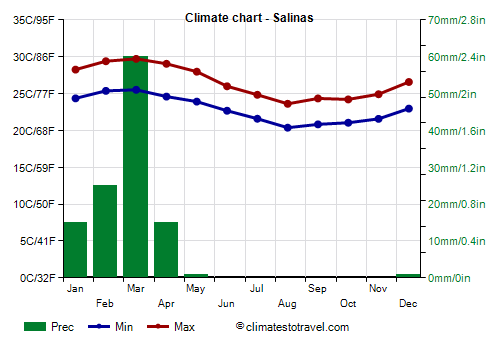 Salinas
Salinas is the westernmost city in Ecuador, and it's located at the tip of the Santa Elena Peninsula. From July to November, temperature becomes quite cool, with highs of 24/25 °C (75/77 °F).
It is true that the rains are generally very scarce even in the rainy period, but in
El Niño years, there can be heavy rains; moreover, the sea can rise, and during high tide, anomalous waves can cause coastal flooding.
In addition, in the rainy period, although it's the warmest of year, sunshine is not so frequent because there is often a haze that veils the sun. In the period from June to November, the heat is less intense, actually, it is almost too cool to go to the beach, and it never rains. It must be said that the amount of sunshine is not very good even in this period, actually, it is even worse.
In the southern part of the coast, the sea becomes a little cool from July to November.
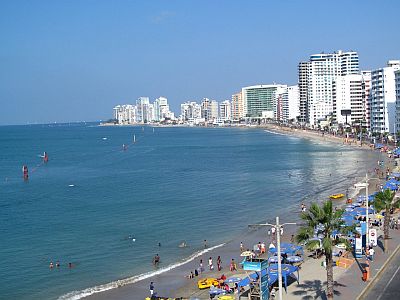
As you move away from the coast, the influence of cool current decreases and the rains increase, reaching the highest levels at the foot of the Andes. From south to north, precipitation ranges from 1,000 mm (40 in) per year in Guayaquil, to 2,000 mm (79 in) in Montoya, to 2,800 mm (110 in) in Santo Domingo de los Colorados, where it rains a lot from February to April, and it still rains heavily enough in June: here, the driest months are definitely
July and August, with less than 40 mm (1.6 in) per month, anyway, rainfall remains below 70 mm (2.8 in) per month from July to November.
Guayaquil
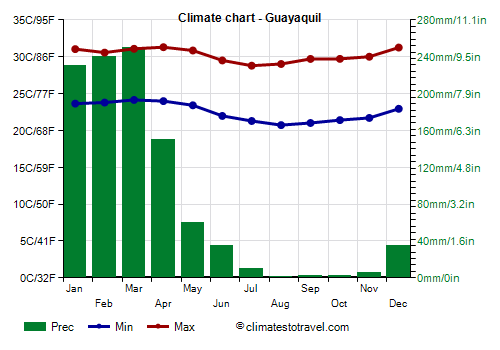
In
Guayaquil, in the south-central part, the distance from the coast, 50 km (30 mi), is sufficient to make the temperatures slightly higher: highs range from 29 °C (84 °F) in June and July to 31 °C (88 °F) in the December-April period.
As mentioned, in Guayaquil, 1,000 mm (40 in) of rain fall per year.
The Andes
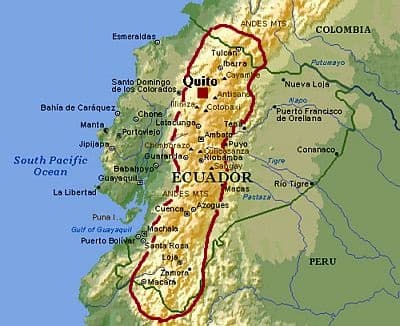
The central part of Ecuador is crossed by
the Andes, which are divided into two mountain ranges and include several volcanoes of considerable height.
Glaciers start at a height of about 5,000 meters (16,500 ft). In the
Cordillera Occidental lies Chimborazo volcano, the highest peak of the country with its 6,268 meters (20,564 feet), while in the
Cordillera Real, we find Cotopaxi, 5,897 meters (19,347 ft), Antisana, 5,704 meters (18,714 ft) and Cayambe, 5,790 meters (18,996 ft).
Quito
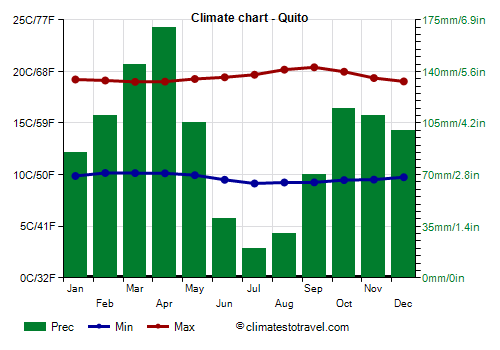
Between the mountain ranges, there is a plateau, where we find important cities, such as
Quito, which is located at 2,850 meters (9,350 ft) above sea level and is the second highest capital in the world. Here, the temperatures are mild, spring-like throughout the year: highs are around 19/20 °C (66/68 °F), although some days can be a bit warmer, and lows are around 9/10 °C (48/50 °F), although the night temperature can sometimes approach the freezing point.
Rainfall in Quito amounts to 1,100 mm (43 in) per year, and it is more frequent and abundant from October to May. Therefore, the best time here is from June to mid-September, but in reality, the only months where it rarely rains are
July and August.
Quito does not get a lot of sun throughout the year, however, the sun shines a bit more frequently in the dry period.
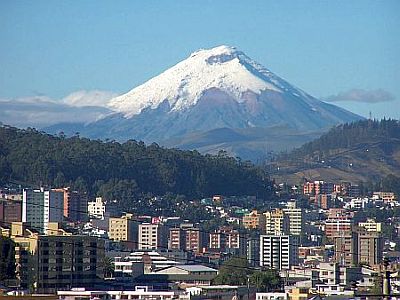
At higher altitudes, the temperature decreases further. At 3,500 meters (11,500 ft), the daily average temperature is around 7/8 °C (45/46 °F) throughout the year, which means that it's cold, and at night it can freeze.
Other cities located at high altitudes in the Andes are drier than the capital. For example, rainfall totals 710 mm (28 in) per year in
Cuenca, in the south, and 625 mm (24.5 in) in Ibarra, in the north.
Along the western slopes of the Andes, even at low altitudes, the sky is often overcast during the coolest and driest season (July-December).
El Niño
As already mentioned, the climate of Ecuador is affected by a cycle in which normal periods alternate with those called
El Niño and La Niña.
During the years of "El Niño", the sea level rises by about 2/3 centimeters (1 inch), the water (and air) temperature rises by a few degrees, and heavy rains affect the coastal zones in the period from December to May, with possible floods. The Andean areas receive more rainfall than usual as well.
On the contrary, during the years of "La Niña", the temperature of the sea (and that of the air as well) becomes cooler than normal, and rainfall becomes scarcer.
When to go
If you want to find a single good period to visit Ecuador, you can choose the Southern Hemisphere's winter, and in particular, the months of
July and August, which are the least rainy, and in some areas also the sunniest months of the year. It must be said, however, that in the forest areas, it rains a lot even in this period, and the amount of sunshine is low. On the other hand, along the west coast, although it rarely rains, the sky is often cloudy.
What to pack
For the Amazon, in the plain, loose-fitting, lightweight clothing of natural fibers, maybe with long sleeves for mosquitoes; possibly a light sweatshirt and a light raincoat for thunderstorms. For the Amazon at low-mountain altitudes (see Puyo), light clothes, a sweatshirt and a light jacket for the evening, and a raincoat.
For the western plain and coast: bring light clothing, a raincoat and a lightweight sweatshirt in the rainy season (December to June in the north, January to April in the south), and a sweatshirt for the evening in the cooler season (June to September).
For the southernmost part of the coast, throughout the year, you can bring a sweatshirt for the evening; from June to September, a sweater or sweatshirt, and a light jacket.
For Quito and the Andes, bring clothes for spring and autumn, a sweatshirt or sweater, a warm jacket for the evening, and a sun hat; a raincoat or umbrella especially from October to May.
For the highest mountains, bring warm clothes, such as a down jacket, a hat, gloves, and a scarf.
See also the
climate of the Galápagos.
Climate data - Ecuador
| Ambato (2,500 meters) |
|---|
|
| Jan | Feb | Mar | Apr | May | Jun | Jul | Aug | Sep | Oct | Nov | Dec |
|---|
| Min temp. | 11 | 11 | 11 | 11 | 11 | 10 | 10 | 9 | 9 | 10 | 11 | 11 |
|---|
| Max temp. | 22 | 21 | 21 | 21 | 20 | 20 | 19 | 19 | 21 | 22 | 23 | 22 |
|---|
| Precip. | 35 | 45 | 60 | 60 | 50 | 55 | 35 | 35 | 40 | 55 | 50 | 40 |
|---|
| Prec. days | 12 | 12 | 15 | 16 | 15 | 14 | 13 | 13 | 12 | 13 | 13 | 12 |
|---|
| Humidity | 66% | 74% | 78% | 75% | 77% | 78% | 76% | 73% | 71% | 70% | 69% | 71% |
|---|
| Day length | 12 | 12 | 12 | 12 | 12 | 12 | 12 | 12 | 12 | 12 | 12 | 12 |
|---|
| Sun hours | 6 | 5 | 4 | 4 | 5 | 5 | 5 | 5 | 5 | 5 | 6 | 6 |
|---|
|
| Cuenca (2,500 meters) |
|---|
|
| Jan | Feb | Mar | Apr | May | Jun | Jul | Aug | Sep | Oct | Nov | Dec |
|---|
| Min temp. | 12 | 12 | 12 | 12 | 12 | 11 | 10 | 9 | 10 | 11 | 11 | 11 |
|---|
| Max temp. | 23 | 23 | 23 | 22 | 22 | 21 | 21 | 21 | 23 | 23 | 24 | 23 |
|---|
| Precip. | 65 | 85 | 105 | 110 | 75 | 70 | 55 | 45 | 55 | 75 | 70 | 65 |
|---|
| Prec. days | 20 | 21 | 22 | 19 | 15 | 11 | 10 | 10 | 12 | 16 | 13 | 10 |
|---|
| Humidity | 69% | 71% | 72% | 72% | 73% | 71% | 67% | 64% | 63% | 67% | 66% | 68% |
|---|
| Day length | 12 | 12 | 12 | 12 | 12 | 12 | 12 | 12 | 12 | 12 | 12 | 12 |
|---|
| Sun hours | 5 | 4 | 4 | 4 | 5 | 5 | 6 | 6 | 5 | 5 | 5 | 5 |
|---|
|
| Esmeraldas |
|---|
|
| Jan | Feb | Mar | Apr | May | Jun | Jul | Aug | Sep | Oct | Nov | Dec |
|---|
| Min temp. | 22 | 23 | 23 | 23 | 23 | 22 | 22 | 22 | 21 | 22 | 22 | 22 |
|---|
| Max temp. | 29 | 29 | 30 | 30 | 29 | 29 | 28 | 28 | 28 | 28 | 28 | 28 |
|---|
| Precip. | 180 | 200 | 185 | 145 | 110 | 105 | 50 | 35 | 45 | 45 | 30 | 55 |
|---|
| Prec. days | 16 | 16 | 14 | 14 | 13 | 14 | 11 | 9 | 9 | 8 | 6 | 8 |
|---|
|
| Day length | 12 | 12 | 12 | 12 | 12 | 12 | 12 | 12 | 12 | 12 | 12 | 12 |
|---|
| Sun hours | 3 | 3 | 4 | 4 | 3 | 3 | 3 | 3 | 2 | 2 | 2 | 2 |
|---|
| Sea temp | 26 | 27 | 26 | 27 | 27 | 27 | 26 | 26 | 26 | 26 | 26 | 26 |
|---|
| Guayaquil |
|---|
|
| Jan | Feb | Mar | Apr | May | Jun | Jul | Aug | Sep | Oct | Nov | Dec |
|---|
| Min temp. | 24 | 24 | 24 | 24 | 23 | 22 | 21 | 21 | 21 | 21 | 22 | 23 |
|---|
| Max temp. | 31 | 31 | 31 | 31 | 31 | 30 | 29 | 29 | 30 | 30 | 30 | 31 |
|---|
| Precip. | 230 | 240 | 250 | 150 | 60 | 35 | 10 | 0 | 0 | 5 | 5 | 35 |
|---|
| Prec. days | 18 | 20 | 20 | 14 | 6 | 2 | 1 | 0 | 0 | 1 | 1 | 4 |
|---|
| Humidity | 71% | 78% | 76% | 73% | 72% | 73% | 73% | 71% | 70% | 70% | 68% | 66% |
|---|
| Day length | 12 | 12 | 12 | 12 | 12 | 12 | 12 | 12 | 12 | 12 | 12 | 12 |
|---|
| Sun hours | 3 | 4 | 4 | 5 | 4 | 3 | 3 | 3 | 3 | 3 | 3 | 4 |
|---|
| Sea temp | 24 | 26 | 25 | 24 | 24 | 23 | 22 | 22 | 22 | 22 | 22 | 23 |
|---|
| Latacunga (2,800 meters) |
|---|
|
| Jan | Feb | Mar | Apr | May | Jun | Jul | Aug | Sep | Oct | Nov | Dec |
|---|
| Min temp. | 9 | 9 | 10 | 9 | 9 | 9 | 8 | 7 | 7 | 8 | 8 | 9 |
|---|
| Max temp. | 20 | 20 | 20 | 19 | 19 | 18 | 18 | 18 | 19 | 20 | 21 | 20 |
|---|
| Precip. | 40 | 65 | 75 | 75 | 50 | 50 | 25 | 25 | 45 | 70 | 65 | 50 |
|---|
| Prec. days | 11 | 11 | 15 | 15 | 12 | 10 | 7 | 6 | 6 | 11 | 14 | 12 |
|---|
| Humidity | 74% | 75% | 77% | 78% | 77% | 77% | 74% | 71% | 70% | 71% | 72% | 74% |
|---|
| Day length | 12 | 12 | 12 | 12 | 12 | 12 | 12 | 12 | 12 | 12 | 12 | 12 |
|---|
| Sun hours | 6 | 5 | 4 | 4 | 5 | 5 | 6 | 6 | 5 | 5 | 5 | 6 |
|---|
|
| Manta |
|---|
|
| Jan | Feb | Mar | Apr | May | Jun | Jul | Aug | Sep | Oct | Nov | Dec |
|---|
| Min temp. | 23 | 24 | 24 | 23 | 23 | 22 | 22 | 21 | 21 | 22 | 22 | 23 |
|---|
| Max temp. | 29 | 29 | 29 | 29 | 29 | 28 | 28 | 28 | 28 | 28 | 28 | 29 |
|---|
| Precip. | 40 | 95 | 70 | 25 | 5 | 5 | 5 | 0 | 0 | 0 | 5 | 5 |
|---|
| Prec. days | 5 | 7 | 6 | 4 | 1 | 1 | 1 | 0 | 0 | 0 | 1 | 1 |
|---|
| Humidity | 78% | 82% | 83% | 81% | 79% | 80% | 80% | 80% | 80% | 79% | 79% | 77% |
|---|
| Day length | 12 | 12 | 12 | 12 | 12 | 12 | 12 | 12 | 12 | 12 | 12 | 12 |
|---|
| Sun hours | 4 | 4 | 5 | 5 | 4 | 3 | 3 | 3 | 3 | 3 | 3 | 3 |
|---|
| Sea temp | 26 | 27 | 27 | 26 | 27 | 26 | 26 | 25 | 25 | 25 | 25 | 26 |
|---|
| Nuevo Rocafuerte |
|---|
|
| Jan | Feb | Mar | Apr | May | Jun | Jul | Aug | Sep | Oct | Nov | Dec |
|---|
| Min temp. | 22 | 23 | 23 | 23 | 23 | 22 | 22 | 22 | 22 | 22 | 23 | 22 |
|---|
| Max temp. | 32 | 32 | 31 | 31 | 30 | 30 | 30 | 31 | 32 | 32 | 32 | 32 |
|---|
| Precip. | 160 | 190 | 205 | 285 | 355 | 320 | 295 | 225 | 240 | 230 | 200 | 155 |
|---|
| Prec. days | 11 | 13 | 17 | 15 | 14 | 16 | 17 | 15 | 13 | 17 | 13 | 13 |
|---|
|
| Day length | 12 | 12 | 12 | 12 | 12 | 12 | 12 | 12 | 12 | 12 | 12 | 12 |
|---|
| Sun hours | 3 | 3 | 2 | 3 | 3 | 2 | 2 | 3 | 3 | 4 | 4 | 4 |
|---|
|
| Puyo (950 meters) |
|---|
|
| Jan | Feb | Mar | Apr | May | Jun | Jul | Aug | Sep | Oct | Nov | Dec |
|---|
| Min temp. | 18 | 18 | 18 | 18 | 18 | 17 | 17 | 16 | 17 | 18 | 18 | 18 |
|---|
| Max temp. | 26 | 26 | 27 | 27 | 26 | 26 | 26 | 27 | 28 | 28 | 28 | 27 |
|---|
| Precip. | 300 | 295 | 390 | 455 | 325 | 390 | 340 | 345 | 355 | 360 | 365 | 370 |
|---|
| Prec. days | 21 | 19 | 22 | 23 | 22 | 22 | 22 | 21 | 21 | 23 | 21 | 21 |
|---|
|
|
| Sun hours | 3 | 2 | 2 | 2 | 3 | 3 | 3 | 3 | 4 | 4 | 4 | 3 |
|---|
|
| Quito (2,850 meters) |
|---|
|
| Jan | Feb | Mar | Apr | May | Jun | Jul | Aug | Sep | Oct | Nov | Dec |
|---|
| Min temp. | 10 | 10 | 10 | 10 | 10 | 10 | 9 | 9 | 9 | 9 | 10 | 10 |
|---|
| Max temp. | 19 | 19 | 19 | 19 | 19 | 19 | 20 | 20 | 20 | 20 | 19 | 19 |
|---|
| Precip. | 85 | 110 | 145 | 170 | 105 | 40 | 20 | 30 | 70 | 115 | 110 | 100 |
|---|
| Prec. days | 10 | 11 | 15 | 15 | 13 | 7 | 5 | 5 | 11 | 14 | 11 | 11 |
|---|
| Humidity | 75% | 75% | 77% | 78% | 76% | 69% | 62% | 58% | 63% | 71% | 76% | 77% |
|---|
| Day length | 12 | 12 | 12 | 12 | 12 | 12 | 12 | 12 | 12 | 12 | 12 | 12 |
|---|
| Sun hours | 5 | 5 | 4 | 5 | 5 | 6 | 7 | 7 | 6 | 5 | 6 | 6 |
|---|
|
| Salinas |
|---|
|
| Jan | Feb | Mar | Apr | May | Jun | Jul | Aug | Sep | Oct | Nov | Dec |
|---|
| Min temp. | 24 | 25 | 26 | 25 | 24 | 23 | 22 | 20 | 21 | 21 | 22 | 23 |
|---|
| Max temp. | 28 | 29 | 30 | 29 | 28 | 26 | 25 | 24 | 24 | 24 | 25 | 27 |
|---|
| Precip. | 15 | 25 | 60 | 15 | 0 | 0 | 0 | 0 | 0 | 0 | 0 | 0 |
|---|
| Prec. days | 4 | 6 | 7 | 4 | 0 | 0 | 0 | 0 | 0 | 0 | 0 | 0 |
|---|
| Humidity | 80% | 81% | 79% | 79% | 80% | 82% | 84% | 84% | 83% | 83% | 80% | 80% |
|---|
| Day length | 12 | 12 | 12 | 12 | 12 | 12 | 12 | 12 | 12 | 12 | 12 | 12 |
|---|
| Sun hours | 4 | 5 | 6 | 6 | 6 | 4 | 4 | 4 | 4 | 4 | 5 | 5 |
|---|
| Sea temp | 24 | 26 | 25 | 24 | 24 | 23 | 22 | 21 | 21 | 22 | 22 | 23 |
|---|
| Tulcan (2,900 meters) |
|---|
|
| Jan | Feb | Mar | Apr | May | Jun | Jul | Aug | Sep | Oct | Nov | Dec |
|---|
| Min temp. | 8 | 8 | 9 | 9 | 8 | 8 | 8 | 7 | 7 | 7 | 8 | 8 |
|---|
| Max temp. | 18 | 17 | 17 | 17 | 17 | 16 | 15 | 16 | 17 | 18 | 18 | 17 |
|---|
| Precip. | 75 | 85 | 95 | 110 | 75 | 60 | 50 | 40 | 50 | 110 | 115 | 95 |
|---|
| Prec. days | 14 | 14 | 16 | 17 | 15 | 15 | 14 | 12 | 12 | 16 | 17 | 17 |
|---|
| Humidity | 76% | 79% | 81% | 79% | 79% | 79% | 80% | 76% | 73% | 76% | 77% | 77% |
|---|
| Day length | 12 | 12 | 12 | 12 | 12 | 12 | 12 | 12 | 12 | 12 | 12 | 12 |
|---|
| Sun hours | 4 | 4 | 3 | 4 | 4 | 4 | 4 | 4 | 4 | 4 | 4 | 4 |
|---|
|
See also the
temperatures month by month